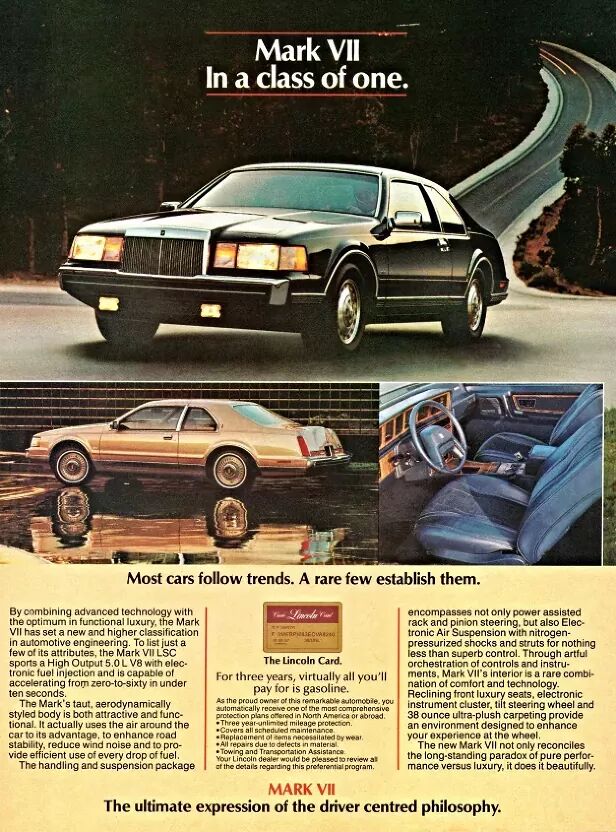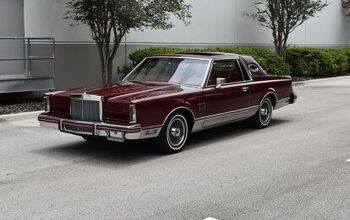Rare Rides Icons: The Lincoln Mark Series Cars, Feeling Continental (Part XXXVII)

As we learned in our last entry, the new for ‘84 Lincoln Continental Mark VII headed in a different direction than any of its PLC predecessors. It was smaller and lighter than even the downsized Mark VI that came before it and rode on the newer Fox platform shared by the Mustang, Thunderbird, Cougar, and indeed the Continental sedan. The Mark’s Eighties evolution was a necessary measure as European luxury competition came in hot, and the disco-traditionalist type PLC customer of the past was no more. Lincoln’s designers had a tall order in the earliest days of the Eighties: Maintain the Mark’s identity generally as a Lincoln and a luxury coupe, and move its looks beyond everything prior to 1984.
The most prominent revision that year was the new Mark’s prow. Though Lincoln’s upright waterfall grille was still bedazzled with chrome and vertical veining, it was less ostentatious than previous Marks III, IV, V, and VI. No longer a vertical slab, the chrome grille leaned back toward the hood slightly and was even curved in its shape. The requisite vertical slats were fewer in number, and thinner than on Mark VI.
And the less is more treatment carried to the edges of the grille, which were more rounded in their presentation and distanced from the Mark VI’s sharp edges. LIncoln’s crosshair hood ornament remained in place atop the grille, as did Mark’s square and red model badge in the center of the grille surround. The grille still stood at the end of the power bulge in the hood, but it was more aerodynamic than on Mark VI and no longer came to a hard central point.
As mentioned in our last entry, flush composite headlamps were a first-of moment for a domestic car and were only legalized just prior to the Mark VI’s launch. The signature formal headlamp doors of other Marks were gone, which assisted Mark VII in looking much more contemporary. Precisely zero European luxury coupes of the period had headlamp doors.
The large square headlamps were flanked by parking and indicator lamps on either side, as another Mark tradition - vertically placed cornering lamps - vanished. Integrated into the fender now, the lamps formed a smoothed corner and trailed down the fender in a way they hadn’t previously.
A welcome modernization occurred lower down at the bumper, where the heavy-handed chrome bar was no more. In its place was a better-integrated bumper with less chrome, and a black front surface. Maintaining a connection to the past, the grille dipped down behind the bumper. Optional for the first time were fog lamps, hung on the bumper to add a sporty look.
Like the Mark VI, VII used chrome lower trim to make the car look longer and more luxurious. A chrome strip started at the corner of the bumper, carried over the front wheel as a thin vein in the expected way, then carried on through to the rear end. It was less chrome than on Mark VI but used in a very similar fashion. Lincoln’s designers knew that for all their other changes in tastes, Americans still liked a large helping of chrome.
The Mark VII’s front end was much more of a wedge than Mark VI, as Lincoln bowed to aerodynamics for the first time in quite a while. Rather than a stark and conservative horizontal fender line, the Mark VII showed that fenders could blend into the rest of the bodywork. A character line started above the corner marker lamp and carried through to the end of the body via a small uptick behind the rear side window. Absent were faux fender vents, never again to appear on a Mark. Small Mark VI lettering appeared in the same place as before, just in front of the door shut line.
Mark VII also adopted side mirrors attached at the front corner of the A-pillar, rather than further back on the door. They were even aerodynamic in their shape! The doors themselves were more rounded than before and carried a character line that was less stiff and a lot more sporty. Chrome door handles persisted as they did before, with a separate lock cylinder to the left as on Mark VI.
Chrome trim was minimized around the A-pillar to two strips: one around the windshield, and one around the window frame. The fully chromed A-pillar was no more; it was newly molded into, and covered by the door itself. The hardtop look was never to return, and the B-pillar was thicker on Mark VII than its predecessor. Aft of the B-pillar was a much larger rear side window, an important change in the Mark’s overall appearance.
Designers shifted away from the formal roof with an opera window, and for the first time in decades, such a window was not even an option. Instead, the larger rear side window allowed rear passengers a better view out and helped the Mark look much sportier. The roof of the Mark VII was not designed to be covered in vinyl or canvas, and for the first time, there were no such factory options from Lincoln. Some got covered anyway, but that was a dealer or aftermarket affair and they looked pretty poor.
A larger side window meant a much narrower C-pillar, a wonderful nod to modern styling and the reduction of blind spots. The Lincoln (or Designer Series) logo appeared on the C-pillar as it had previously. Likely few noticed, but the fuel door moved to the right on the Mark VII. Beneath said door was a red corner marker lamp, placed higher up on the body than Mark VI.
More streamlined roof arrangements meant a larger rear window, and a sloping rear edge to the C-pillar than looked much faster than any prior Mark. A greatly shortened trunk lid meant less rear overhang, and the lid’s edges were more rounded. Lincoln’s designers knew they had to maintain the faux Continental tire hump, though it was even softer (as was the trend over the prior couple of revisions).
For the first time, a Lincoln logo appeared in the middle of the tire hump but was not accompanied by Continental block lettering. Other simplifications at the rear included a slimmer bumper to match the one at the front. The license plate migrated upward and took a portion of the tire hump as its home. On either side of it were red reflector lamps that contained the reversing lights. The moves left a much cleaner rear bumper area.
At either corner were the expected near-vertical tail lamps, which wore a more rounded design than older Marks. They wrapped around the corner of the car rather than sticking out as their own edge. Ribbed lens detailing was also a thing of the past. Though chrome still ensconced the lenses, it was much thinner.
The interior of the Mark VII changed almost as much as the exterior when the new generation adopted a fresh, modern look. Kicking the traditionalists to the curb once and for all, there wasn’t even a bench seat available in the Mark VII! We’ll pick it up there next time.
[Images: Ford]
Become a TTAC insider. Get the latest news, features, TTAC takes, and everything else that gets to the truth about cars first by subscribing to our newsletter.

Interested in lots of cars and their various historical contexts. Started writing articles for TTAC in late 2016, when my first posts were QOTDs. From there I started a few new series like Rare Rides, Buy/Drive/Burn, Abandoned History, and most recently Rare Rides Icons. Operating from a home base in Cincinnati, Ohio, a relative auto journalist dead zone. Many of my articles are prompted by something I'll see on social media that sparks my interest and causes me to research. Finding articles and information from the early days of the internet and beyond that covers the little details lost to time: trim packages, color and wheel choices, interior fabrics. Beyond those, I'm fascinated by automotive industry experiments, both failures and successes. Lately I've taken an interest in AI, and generating "what if" type images for car models long dead. Reincarnating a modern Toyota Paseo, Lincoln Mark IX, or Isuzu Trooper through a text prompt is fun. Fun to post them on Twitter too, and watch people overreact. To that end, the social media I use most is Twitter, @CoreyLewis86. I also contribute pieces for Forbes Wheels and Forbes Home.
More by Corey Lewis
Latest Car Reviews
Read moreLatest Product Reviews
Read moreRecent Comments
- Lou_BC Well, I'd be impressed if this was in a ZR2. LOL
- Lou_BC This is my shocked face 😲 Hope formatting doesn't fook this up LOL
- Lou_BC Junior? Would that be a Beta Romeo?
- Lou_BC Gotta fix that formatting problem. What a pile of bullsh!t. Are longer posts costing TTAC money? FOOK
- Lou_BC 1.Honda: 6,334,825 vehicles potentially affected2.Ford: 6,152,6143.Kia America: 3,110,4474.Chrysler: 2,732,3985.General Motors: 2,021,0336.Nissan North America: 1,804,4437.Mercedes-Benz USA: 478,1738.Volkswagen Group of America: 453,7639.BMW of North America: 340,24910.Daimler Trucks North America: 261,959






































Comments
Join the conversation
If your town had no golf course or only one country club this was the bomb in 1984. If your town had a country club and a yacht club, European iron was the thing to drive in 1984.
Proportions were badly affected by the short Fox wheelbase, but even so this was the best-looking Lincoln since the early 1960s. Wish they had been able to continue in this vein; a Mark 9 again based on a stretched Mustang chassis could be a halo product.